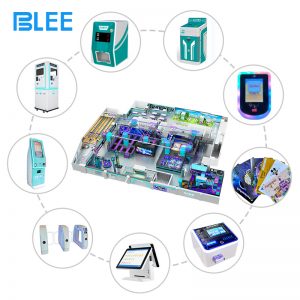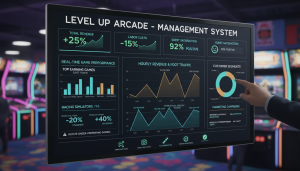Introduction
Designing a Family Entertainment Center (FEC) layout is far beyond just creating an attractive environment. It is a precise discipline that involves engineering guest flow, optimizing equipment placement, and maximizing spend loops in order to significantly boost profitability. Leveraging BLEE’s global expertise as a leading arcade turnkey solution and arcade full project supplier, this article reveals actionable, industry-proven strategies to elevate ROI per square foot using modular, data-driven layout planning combined with operational efficiency.
1. Understanding the Profit-Physics of FEC Layouts
1.1 The Business Imperative: From Zoning to Spend Loops
A critical mindset shift is needed from merely designing “nice-looking zones” to crafting measurable revenue circuits. The core concept revolves around three powerful pillars: Loops, Lines, and Labor. These elements monetize aisles and queue spaces that traditionally are underestimated, turning every footstep into potential revenue by creating well-defined spend loops that guide guests through high-value zones and impulse areas.
1.2 Key Metrics Affecting Profitability
Several metrics dictate the success of your FEC layout:
- Return on Area (ROA) per aisle meter – understanding which areas yield the highest revenue per square foot.
- Guest per capita spend benchmarks – with IAAPA’s 2023 data citing an average of $100 per guest.
- Labor cost optimization – smart designs reduce staff burdens and operational expenses through efficient visibility and equipment access.
1.3 BLEE’s Modular Equipment Clusters as Profit Accelerators
BLEE’s modular clusters are designed to amplify profitability by placing complementary machines in close proximity. For example:
- Claw machines paired with light skill games near entrances engage guests immediately and drive impulse spends.
- Basketball and ticket redemption games strategically located adjacent to party rooms capitalize on group traffic and high engagement.
- VR anchors equipped with noise and power buffer zones ensure immersive experiences without disrupting the overall floor flow.
2. Mapping and Engineering Guest Flow: A/B/C Circuits
2.1 Defining Guest Circuits by Spend Potential and Behavior
Guest flow in an FEC should be deliberately engineered into distinct circuits based on spend potential and behavior:
- A-circuit: Houses high-value, immersive attractions and anchor games that draw guests deeply into the center.
- B-circuit: Features medium-engagement skill games and redemption zones that balance interaction and revenue.
- C-circuit: Comprises transit pathways and impulse spending areas optimized for quick buys and cross-promotions.
2.2 Designing Fluid Pathways with Optimal Lines-of-Sight
Clear, unobstructed sightlines to redemption counters and Food & Beverage (F&B) areas are vital. Avoiding “dead zones” and bottlenecks reduces guest frustration, encourages longer dwell times, and supports repeat visits.
2.3 Monetizing Queues and Wait Times with Strategic Layout
Queues are prime real estate for boosting revenue through thoughtful placement of amenities and merchandise. Queue-based beverage and merchandise stations can increase per-capita spend by approximately 22%. Incorporating in-line interactive displays and impulse purchase points during wait times transforms potential guest frustration into enjoyable engagement, enhancing the overall experience.
According to the Botrista 2023 study, these queue-based strategies have proven especially lucrative in theme parks and can be adapted effectively to FEC arcade centers.
3. Balancing Equipment Mix and Space Allocation
3.1 Optimal Anchor Attraction Investment vs Redemption Counters
Market insights reveal that redemption games alone constitute approximately 41.2% of FEC revenue projected for 2024. It is imperative to avoid under-sizing both the high-conversion ticket games and prize redemption points to capture maximum spend from guests.
3.2 Equipment Categories and Strategic Placement
BLEE’s extensive product range includes grabbers, shooters, VR experiences, sports simulators, and gashapon machines. Each category demands zoning consideration based on noise levels, power requirements, and maintenance accessibility:
- Noisy or power-intensive attractions like VR need acoustic buffers and dedicated power management.
- Easily accessible maintenance zones prevent costly downtime.
- Zoning reduces guest fatigue and optimizes the service crew’s efficiency.
3.3 Comparative Table: Equipment Cluster Benefits and Space Requirements
| Equipment Type | Space Needs | Revenue Impact | Noise/Power Considerations | Maintenance Complexity |
|---|---|---|---|---|
| Claw Machines | Low | High (impulse) | Low | Low |
| Redemption Counters | Moderate | Very High | Moderate | Moderate |
| VR & Simulators | High | High | High (power/cooling) | High |
| Interactive Sports | Moderate | Medium | Moderate | Moderate |
Selecting the right balance of equipment, tailored to your market and guest preferences, supports sustained profitability and guest delight.
4. Efficient Serviceability: Labor, Maintenance & Safety
4.1 Designing Service Corridors and Operational Zones
Effective arcade layout planning includes creating service corridors and operational zones that minimize labor costs and reduce downtime. Clear lines-of-sight enable staff to monitor guest areas while maintenance lanes provide unhindered access for repairs and cleaning. Pre-planning power logistics helps avoid technical disruptions.
4.2 Complying with Safety and Egress Standards
Safety is paramount. The NFPA 101 egress code requires aisle widths calculated by the occupant load multiplied by 0.2 feet per person, with a minimum of 36 inches aisle width to ensure swift and safe evacuation. Door and corridor clearance guidelines must prevent obstructions during ingress and egress, maintaining compliance and protecting patrons.
4.3 Energy and Acoustic Fatigue Management
Optimized placement of noisy VR anchors with appropriate acoustic buffers protects guest comfort and staff well-being. Balanced power distribution reduces peak load stress, enhancing equipment longevity and cutting energy costs.
5. Iterative Layout Validation and Optimization
5.1 The 90-Day Re-layout Sprint Model
A dynamic approach to layout design, the 90-day re-layout sprint model helps operators track revenue and foot traffic in real-time, then adapt modular BLEE equipment clusters accordingly. Key metrics include ROI per section, queue conversion rates, and spend per loop, enabling data-driven decisions for continuous improvement.
5.2 Data-Driven Decision Making with Heatmaps and Guest Tracking
Using occupancy and revenue heatmaps to analyze guest behavior helps identify underperforming zones that require adjustments. This approach, inspired by slot floor heatmap strategies applied in casinos, has been successfully adapted for FEC arcade zones, providing granular insights for layout tweaking and profit maximization.
Supporting research can be found in the UNLV Research 2024.
5.3 Leveraging BLEE’s One-Stop Solutions for Rapid Iterations
BLEE provides an integrated arcade one-stop solution that covers design, manufacturing, installation, and after-sales support, expediting layout iterations and minimizing downtime. BLEE’s products follow global certifications such as CE, RoHS, and ISO, ensuring seamless market entry and regulatory compliance.
6. Integrating Food & Beverage and Party Areas to Boost Spend
6.1 Strategic Placement Around Ticket Redemption and Party Rooms
Locating quick-service F&B kiosks near high-spend redemption areas effectively increases dwell time and incremental spend. Party rooms situated adjacent to interactive game clusters attract groups, further driving revenue through longer visits and combined experiences.
6.2 Queue-Based Merchandising and Impulse Sales Integration
Merchandise and beverage stations placed within queue lines help convert waiting times into spontaneous purchases. This tactic, proven in theme parks, can boost revenue without compromising guest experience.
The Tensator Group highlights the benefits of strategic in-queue merchandising, confirming the potential uplift for amusement centers.
6.3 Balancing Guest Experience with Commercial Objectives
While maximizing revenue is essential, maintaining smooth flow and minimizing congestion keeps guests happy and encourages repeat visits. Thoughtfully designed layouts integrate commercial objectives without sacrificing the family-friendly environment.
FAQ – Family Entertainment Center Layout Design
Q1: What is the average revenue per square foot for a profitable FEC?
Industry benchmarks indicate an average of around $100 per square foot annually, with top performers surpassing this through optimized layouts and strategic equipment mix.
Q2: How does queue design affect customer spending in family entertainment centers?
Well-designed queues that incorporate merchandising and beverage stations can increase per-capita spend by up to 22%, while also improving guest satisfaction by reducing perceived wait times.
Q3: What safety regulations should be considered in arcade layout planning?
Layouts must comply with NFPA 101, which mandates minimum aisle widths (at least 36 inches), door clearance protocols, and other egress criteria based on occupancy to ensure safe evacuation.
Q4: How important is equipment modularity in layout optimization?
Modularity is critical for enabling rapid reconfigurations during iterative optimization cycles, such as the 90-day sprint model, allowing operators to respond swiftly to guest behavior and revenue data.
Q5: Can BLEE support international arcade project compliance and installation?
Yes, BLEE offers internationally certified products, comprehensive OEM/ODM customization, and full after-sales and installation support to ensure global compliance and operational success.
Q6: What are spend loops and why are they vital in FEC layout design?
Spend loops are traffic circuits designed to maximize guest exposure to revenue-generating zones. They are vital as they guide guests naturally through high-engagement machines and merchandise points, increasing time spent and money spent per visit.
Q7: How does guest flow impact operational efficiency?
Well-engineered guest flow minimizes bottlenecks and dead zones, improving guest satisfaction and simplifying staff supervision, which in turn reduces labor costs and equipment downtime.
Q8: What role do redemption counters play in revenue maximization?
Redemption counters drive significant revenue, facilitating prize redemptions that encourage spending. Adequate sizing and strategic placement near high traffic zones are essential to avoid customer frustration and missed sales.
Q9: How can technology assist in FEC layout optimization?
Real-time occupancy tracking and revenue heatmaps provide invaluable insights into guest behavior, helping management pinpoint hotspots and underperforming areas for timely adjustments.
Q10: What is an arcade turnkey solution and how does it benefit FEC operators?
An arcade turnkey solution like BLEE’s offers end-to-end project delivery, including design, equipment supply, installation, and post-installation support. This integration shortens project timelines, ensures compliance, and guarantees coherent operational workflows.







